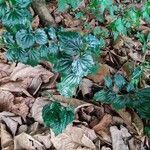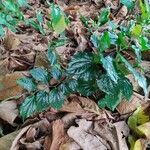Herbs to more than 10 m, mostly creeping along ground, most parts very finely powdery pubescent at least when young, dioecious. Fertile stems ± erect. Petiole 2-5 cm (-10 cm on creeping stems), very finely powdery pubescent; leaf blades toward base of stem ovate to suborbicular, those toward apex of stem smaller, ovate or ovate-lanceolate, 7-14 × 6-13 cm, ± membranous, finely glandular, abaxially finely powdery pubescent along veins, adaxially glabrous, base cordate to rounded, sometimes cuneate on apical branches, ± symmetric, apex acute; veins 7, glaucous when dry, abaxially very prominent, apical pair arising 1-2 cm above base, reaching leaf apex; reticulate veins conspicuous. Spikes leaf-opposed. Male spikes white, 1.5-2.5(-3) cm × 2-3 mm; peduncle to ca. as long as spikes; rachis pubescent; bracts transversely elliptic, 0.5-0.6 mm, peltate, ± sessile. Stamens 2; filaments ca. 2 × as long as anthers; anthers subglobose. Female spikes 2-5(-8) cm, to 8 mm thick in fruit; peduncle as in male spikes; rachis glabrous; bracts suborbicular, peltate, 1-1.3 mm in diam. Stigmas (3 or)4(or 5), hispidulous. Drupe subglobose, 4-angled, 2.5-3 mm, partly connate to rachis. Fl. Apr-Nov.
More
A creeper with an erect stem. It is 50 cm high. The creeper or vine can be 10 m long. There are very fine powdery hairs when young. The leaves are finer and more tender than Piper betel. They are brighter green with distinct veins. The leaf stalk is 2-5 cm long. The leaf blades are larger near the base. They are 7-14 cm long by 6-13 cm wide. The leaf base is rounded or heart shaped and tapers to a short tip. The fertile stem stick upwards. The spikes are opposite the leaves. The spikes hang downwards. The male spikes are white and 1.5-2.5 cm long by 2-3 mm wide. The female spikes are 2-5 cm long by 8 mm wide in fruit. The fruit is 4 angled and 2.5-3 mm across. The fruit is a single seeded berry.
A tropical plant. It grows in forests in wet places near villages and from near sea level to 1000 m altitude in S China. It does best is shady places. It grows in humid locations in forests. In Hawaii it is grown under shade cloth. Dry winds turn the leaves brown spoiling their appearance. In Yunnan.
More
Forests or wet places near villages from near sea level to 1,000 metres. Edges of semi-evergreen type forests at or near sea level in the Andamans.
The leaf is slightly pungent and is eaten raw. They are also added to curries or blanched and eaten as a potherb. The leaves are used to wrap an Asian snack dish. They are also used in soups. The dried fruit is used as a spice. The leaves are chewed with betle nut. The leaves are used as a flavouring for meat dishes.




